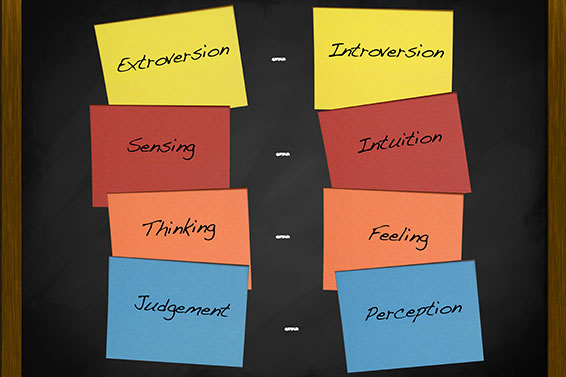Myers-Briggs Type Indicator (MBTI)
Isabel Myers and her daughter took Jung’s theories about perception and judgment and applied them to individual behavioral patterns, creating the Myers-Briggs Type Indicator. Since everyone perceives things differently, it is reasonable to assume that each person will react differently to different interests, values, motivations, and skills.
Definitions
- Perception involves how individuals become aware of people, things ideas, or events.
- Judgement involves how individuals develop conclusions based on what they perceive.
Bipolar Scales
This indicator looks at four different bipolar scales:
- Extraversion (E) – Introversion (I)
- Sensing (S) – Intuition (N)
- Thinking (T) – Feeling (F)
- Judgment (J) – Perception (P)
MBTI Types
Individuals choose their preferences resulting in sixteen different MBTI types. These scales look at:
- Attitudes (EI)
- Processes of perception (SN)
- Processes of judgment (TF)
- Styles of dealing with the outside world (JP)
Primary Preferences
The MBTI provides individuals with a four-letter combination that identifies their primary preference. Then combinations of letters indicate:
- How individuals deal with change (EI/JP)
- Career interests (SN/TF)
- Ways information is used (EI/SN)
- Leading/Following styles (TF/JP)
- Temperaments (SN/TJ) (Myers, 1998).
MBTI Traits
The table below identifies the traits assessed on the MBTI (Myers & McCaulley, 1998, pp. 12-14).
| Scale | Trait | Tends to… | ||
| Perception | Sensing | Focus on immediate experiences and enjoy each moment, have acute powers of observation and a memory for detail. | ||
| Intuition | Be imaginative, abstract, creative, and future-oriented. | |||
| Judgment | Thinking | Link ideas together by making logical connections; be analytical, objective, fair, and critical. | ||
| Feeling | Make decisions by weighing values and merits of self and others; be understanding, warm, and concerned for others. | |||
| Attitude | Extraversion | Act on the need to be part of the environment both objects and people; be action-oriented, impulsive, frank, and sociable. | ||
| Introversion | Act independently and prefers his/her own thoughts and ideas; be thoughtful, contemplative, and enjoy both privacy and solitude. | |||
| Orientation to Outer World | Perception | Be attuned to incoming information; be spontaneous, curious, adaptable, and open to change. | ||
| IF… | THEN information provides… | |||
| Sensing-perceptive (SP) | More immediate realities | |||
| Intuitive-perceptive (NP) | New possibilities | |||
| Judgment | Be concerned with making decisions, planning, organization, and finalizing things; be organized, purposeful, and decisive. | |||
| IF… | THEN decisions tend to be based on… | |||
| Thinking-judging (TJ) | Logical analysis | |||
| Feeling-judging (FJ) | Human factors | |||
References
Hammer, A. L. (Ed.). (1993). MBTI Applications: A decade of research on the Myers-Briggs Type Indicator. Palo Alto, CA: Consulting Psychologists Press.
Myers, I. B. (1998). Introduction to type (6th Ed.). Palo Alto, CA: Consulting Psychologists Press.
Myers, I. B., & McCaulley, M. H. (1985). Manual: A guide to the development and use of the Myers-Briggs Type Indicator. Palo Alto, CA: Consulting Psychologist Press.

